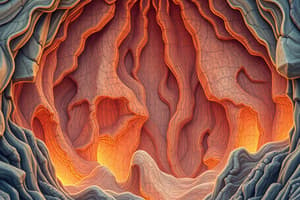Podcast
Questions and Answers
At which type of plate boundary would you expect to find a deep ocean trench?
At which type of plate boundary would you expect to find a deep ocean trench?
- Destructive (correct)
- Conservative
- Transform
- Constructive
Which of the following is NOT a factor that influences the risk posed by natural hazards?
Which of the following is NOT a factor that influences the risk posed by natural hazards?
- Geographic location of the hazard
- Population density
- Distance from the equator (correct)
- Wealth of the country
- Climate change
What is the primary force driving the movement of tectonic plates?
What is the primary force driving the movement of tectonic plates?
- Convection currents (correct)
- Tidal forces
- Gravity
- Wind
Which type of plate boundary is associated with the formation of new crust?
Which type of plate boundary is associated with the formation of new crust?
What is the main process that leads to volcanic eruptions at destructive plate margins?
What is the main process that leads to volcanic eruptions at destructive plate margins?
Which of the following examples is a result of a conservative plate margin?
Which of the following examples is a result of a conservative plate margin?
Which of the following natural hazards is most likely to be caused by the movement of tectonic plates?
Which of the following natural hazards is most likely to be caused by the movement of tectonic plates?
Which of the following statements about plate tectonics is TRUE?
Which of the following statements about plate tectonics is TRUE?
What are the main causes of earthquakes that are not related to plate margins?
What are the main causes of earthquakes that are not related to plate margins?
What is the primary reason for the vulnerability of the Kaikoura, New Zealand region to earthquakes?
What is the primary reason for the vulnerability of the Kaikoura, New Zealand region to earthquakes?
In terms of impact, which of the following was a significant secondary effect of the 2016 Kaikoura earthquake?
In terms of impact, which of the following was a significant secondary effect of the 2016 Kaikoura earthquake?
Which of the following is a long-term response to the 2015 Nepal earthquake?
Which of the following is a long-term response to the 2015 Nepal earthquake?
What factor contributed to the limited effectiveness of rescue efforts in the immediate aftermath of the 2015 Nepal earthquake?
What factor contributed to the limited effectiveness of rescue efforts in the immediate aftermath of the 2015 Nepal earthquake?
What factor explains why many people continue to live near volcanoes?
What factor explains why many people continue to live near volcanoes?
Which of the following is a factor that does not significantly affect the decision of individuals to live near volcanoes?
Which of the following is a factor that does not significantly affect the decision of individuals to live near volcanoes?
What is the primary reason people in wealthier nations may choose to live in areas with earthquake risks?
What is the primary reason people in wealthier nations may choose to live in areas with earthquake risks?
What feature distinguishes the Kaikoura earthquake from the 2015 Nepal earthquake in terms of the plate boundary type?
What feature distinguishes the Kaikoura earthquake from the 2015 Nepal earthquake in terms of the plate boundary type?
What is the primary benefit of volcanic ash to soil fertility?
What is the primary benefit of volcanic ash to soil fertility?
Which of the following statements is true in relation to the relationship between earthquakes and volcanoes?
Which of the following statements is true in relation to the relationship between earthquakes and volcanoes?
Which of the following countries is located on the Pacific 'Ring of Fire'?
Which of the following countries is located on the Pacific 'Ring of Fire'?
Which of the following actions was not a feature of the immediate response to the Kaikoura earthquake?
Which of the following actions was not a feature of the immediate response to the Kaikoura earthquake?
What was a significant barrier to aid distribution and rescue operations in the immediate aftermath of the 2015 Nepal earthquake?
What was a significant barrier to aid distribution and rescue operations in the immediate aftermath of the 2015 Nepal earthquake?
Why is the 'Ring of Fire' an area of high volcanic and earthquake activity?
Why is the 'Ring of Fire' an area of high volcanic and earthquake activity?
Flashcards
Natural Hazard
Natural Hazard
An occurrence in the physical environment that harms humans, driven by forces like tectonics or weather.
Tectonic Plates
Tectonic Plates
Large pieces of Earth's crust that move slowly and can cause earthquakes and volcanoes at their boundaries.
Destructive Margin
Destructive Margin
Where an oceanic plate is subducted under a continental plate, causing earthquakes and volcanoes.
Conservative Margin
Conservative Margin
Signup and view all the flashcards
Constructive Margin
Constructive Margin
Signup and view all the flashcards
Factors Affecting Hazard Risk
Factors Affecting Hazard Risk
Signup and view all the flashcards
Earthquake
Earthquake
Signup and view all the flashcards
Volcano
Volcano
Signup and view all the flashcards
Magma movement
Magma movement
Signup and view all the flashcards
Earthquake belts
Earthquake belts
Signup and view all the flashcards
Pacific Ring of Fire
Pacific Ring of Fire
Signup and view all the flashcards
Magnitude scale
Magnitude scale
Signup and view all the flashcards
Primary effects of earthquakes
Primary effects of earthquakes
Signup and view all the flashcards
Secondary effects of earthquakes
Secondary effects of earthquakes
Signup and view all the flashcards
Immediate responses to earthquakes
Immediate responses to earthquakes
Signup and view all the flashcards
Long-term responses to earthquakes
Long-term responses to earthquakes
Signup and view all the flashcards
Destructive plate boundary
Destructive plate boundary
Signup and view all the flashcards
Volcanic soil fertility
Volcanic soil fertility
Signup and view all the flashcards
Causes of human-induced earthquakes
Causes of human-induced earthquakes
Signup and view all the flashcards
GDP per capita impact
GDP per capita impact
Signup and view all the flashcards
Tourism near volcanoes
Tourism near volcanoes
Signup and view all the flashcards
Earthquake preparedness
Earthquake preparedness
Signup and view all the flashcards
Fracking effects
Fracking effects
Signup and view all the flashcards
Study Notes
Natural Hazards
- Natural hazards occur when natural forces (e.g., tectonic activity, weather) cause harm to humans.
- Examples include: tsunamis, droughts, supervolcano eruptions, avalanches, blizzards, forest fires, sinkholes, mudslides, flash floods, tropical storms, volcanoes, and earthquakes.
Factors Affecting Hazard Risk
- Wealth: A country's wealth impacts its ability to prepare for and cope with hazards.
- Population Density: High population density areas are more vulnerable to hazard impacts.
Earth Structure and Plate Tectonics
- Earth's crust is divided into tectonic plates, which are constantly moving.
- Plate boundaries (margins) are locations where earthquakes, volcanoes, mountains, and ocean trenches form.
- About 8 major plates and many smaller ones exist.
- Plate movement is largely driven by convection currents in the Earth's mantle.
Types of Plate Margins
- Destructive Margin: An oceanic plate subducts beneath a continental plate, causing earthquakes, volcanoes, and forming trenches and fold mountains. (e.g., Nazca and South American plates)
- Conservative Margin: Two plates slide past each other, resulting in powerful earthquakes. (e.g., San Andreas Fault)
- Constructive Margin: Two plates move apart, creating a gap filled by magma, leading to volcanic eruptions and gentle earthquakes. (e.g., mid-Atlantic ridge)
Earthquake Locations
- Earthquakes are commonly found in bands aligning with plate margins (e.g., Pacific Ring of Fire, mid-Atlantic).
- Some earthquakes occur away from plate boundaries, potentially due to human activities (e.g., fracking).
Volcano Locations
- Volcanoes are often located along plate margins.
- A significant belt encircles the Pacific Ocean (Pacific Ring of Fire), and another exists along the mid-Atlantic ridge.
Case Study: 2016 New Zealand Earthquake (Kaikoura)
- Magnitude: 7.8
- Primary Effects: 2 fatalities, injuries, damaged/destroyed homes, economic losses, and infrastructure damage.
- Secondary Effects: Landslides, flooding, tsunami.
- Immediate Responses: Tsunami warning, emergency housing, power and water restoration. International aid.
- Long-Term Responses: Funding for reconstruction, road and rail repair, community support initiatives, and earthquake-resistant infrastructure development.
Case Study: 2015 Nepal Earthquake
- Magnitude: 7.8
- Primary Effects: Thousands of deaths and injuries, numerous damaged/destroyed buildings widespread homelessness, significant economic loss, and water/sanitation issues.
- Immediate Responses: International aid, rescue efforts, emergency support by NGOs and aid organisations.
- Long-Term Responses: Relief efforts for recovering from destroyed building, World Bank financed reconstruction projects to build earthquake resistant housing, and improve infrastructure.
Reasons for Living Near Hazards
- Limited alternatives/affordability: Moving away might not be an option
- Familiarity: The people and places are well known.
- Effective monitoring/governance: Risk is minimized through preparedness and responses.
- Economic activity: Opportunities for tourism and agriculture.
- Fertile soil: Volcanic activity results in high-quality soil for crops.
Studying That Suits You
Use AI to generate personalized quizzes and flashcards to suit your learning preferences.




